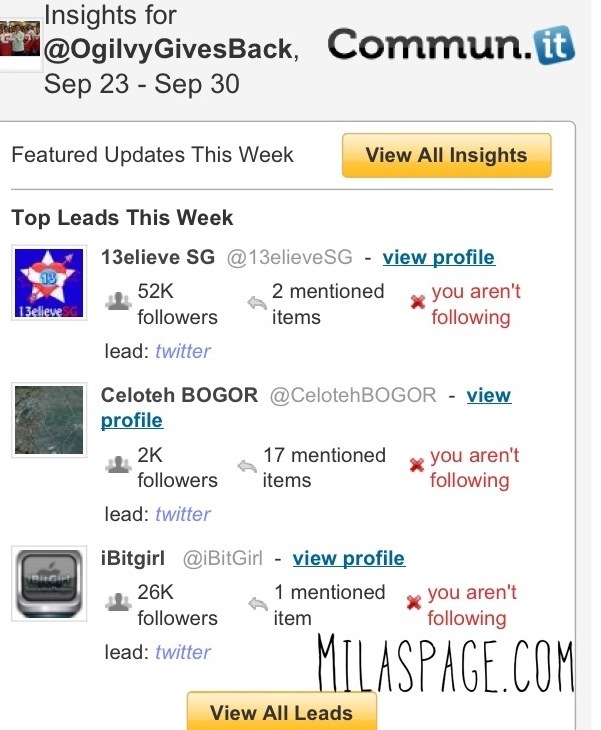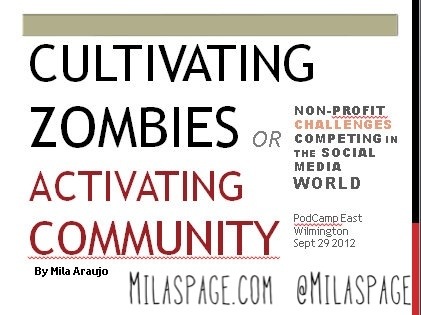I had the pleasure of speaking at PodCamp East recently. My talk was on “Cultivating Zombies or Activating communities“. We covered quite a bit of ground, so, I thought I would highlight some of the tips we talked about the focus was strategies for non-profits to consider when evaluating a social media presence.
I will be putting up the complete slide share and additional notes and resources shortly!
This might be a good time to sign up for my newsletter by email on the right, or download my mobile app this way you will get notified whenever something is posted !
To those who came to the presentation thank you! It was amazing to have the opportunity to share ideas about our changing the world by getting more people involved!
Here are your 10 tips:
(Notice getting more followers and likes on Facebook is not on here – that’s for the Zombie post! )
1. Start blogging OR create a blog type site:
This allows you to tell deeper stories, a critical aspect of building relationships
Also an important tool for reaching others who will be looking for your services online or looking for causes to support in their local area. If you’re not showing up when they try to find you, how will you get the support?
Blogging provides a platform for you to use as a home base. Anything you post elsewhere, can be brought onto your blog.
***Tip: If writing a blog is overwhelming and your primary social media activities will be focused on other platforms like Twitter, Instagram or YouTube, you can always get resourceful and use a service like Overblog to pull it all together for you and display it in a blog format. It is very easy to set up and a very interesting option for non-profits. It will also allow for you to write blog posts when the need arises or you are ready to start.
Blogs also allow you to address concerns or frequently asked questions that you encounter daily in the public eye. It serves as a resource not only to support your projects but to reassure people about things they would otherwise be concerned about, for example, allocation of funding – how much of what they donate goes to helping – just one small example that can help bring more donors in!
2. Activate a Twitter Account
Your Twitter account can be used to reach new people, identify others who you might be able to collaborate with and find influencers and supporters to help you in your cause.
You can also use Twitter to have brainstorming sessions with others who share similar interests, or promote events through hashtag chat.
3. Sign up for a social media helper tool
Commun.it andNimble -both have free versions. These will help you manage communication with your community.
Nimble is neat because it pulls all your social accounts into one place – in an “email style” interface. For people trying to make sense of the flow of messages from social sites, it pulls it together so you can read and manage all in one place just like email. I also like the feature of creating follow up actions and scheduling events around your online contacts. It helps keep track of the relationships you are building and future plans and actions.
Commun.it shows engagement opportunities, reminds you to respond to “mentions” and also monitors who us talking about you, and identifies potential new relationships to pursue.
Here’s a screen shot of the kind of thing it will send you by email, to keep you on track, pretty cool!

It’s very user friendly, definitely a tool to check out! Here’s a link for the invite.
For documenting events that receive online attention, you can also check out Storify, I covered it in a previous post here.
4. Tell your story
The most important aspect of gaining support in a non profit using social media is getting people and organizations to connect with you so they feel that they want to support you. Take the time to dig into your “raison d’être” (reason of being) and share this. Make sure to always connect your story back to your community, your sponsors – they need to understand why they should care and why supporting you is important to them. Draw the connections.
5. Start using video
YouTube, Google hang outs, or and easy mobile app like Tout and Vine give lots of opportunities to share moments, conversations, presentations and brainstorming sessions.
6. Activate an email campaign
Consider using a service like Constant Contact or Mail Chimp. Email is still important. Use this instead of traditional direct mail or even regular email. It will not only provide you with an easy way to keep in touch, it will provide stats on who has seen it, clicked through on your links, etc.
I’d like to point out that Constant Contact is a sponsor of PodCamp – I like to support organizations that sponsor events and causes- so give them a thank you shout out and keep them in mind 🙂
(By the way the link above to Thank Constant Contact is an example of what we talked about in our talk re: using social tools to make it easy for your community to help recognize sponsors and partners) – try it!
7. Get out into your community and let people know about all this in person!
You have to supplement online activity with real life contact and events. Find people who are interested in your cause, and then share your message. Plan talks or events to raise awareness. Let people know how they can stay in touch and help online!
8. Keep Traditional Media In The Loop
Send a media release about what you’re doing – whenever you have news, or something new to say – contact the local media. People still watch tv and read newspapers. Don’t forget this as part of our strategy and direct them to your social sites for more information.
9. Use pictures
People do not have a lot of time. Sharing photos is a quick easy way to communicate messages and feelings. Use photos to recognize partners, volunteers, show results of people’s contributions. A great way to give results to the community that supports you and to entertain and recognize them!
@EpicChange does a great job of using Instagram – sharing photos of the kids who graduated from the school they built. A great way to make people feel good!
10. Find like minds to collaborate with & learn from
Follow bloggers and organizations that provide content focusing on the same goals as yours – fundraising and sharing the story of their missions – these will be your teachers . Don’t forget to share their stories too!
These are 10 quick tips to make sure you’re moving in the right direction. In my next post, I will include the slides. Stay tuned and thank you for a great event today!
- What tricks or tips do you use to keep community engaged?
- Are you cultivating zombies, or activating community?
